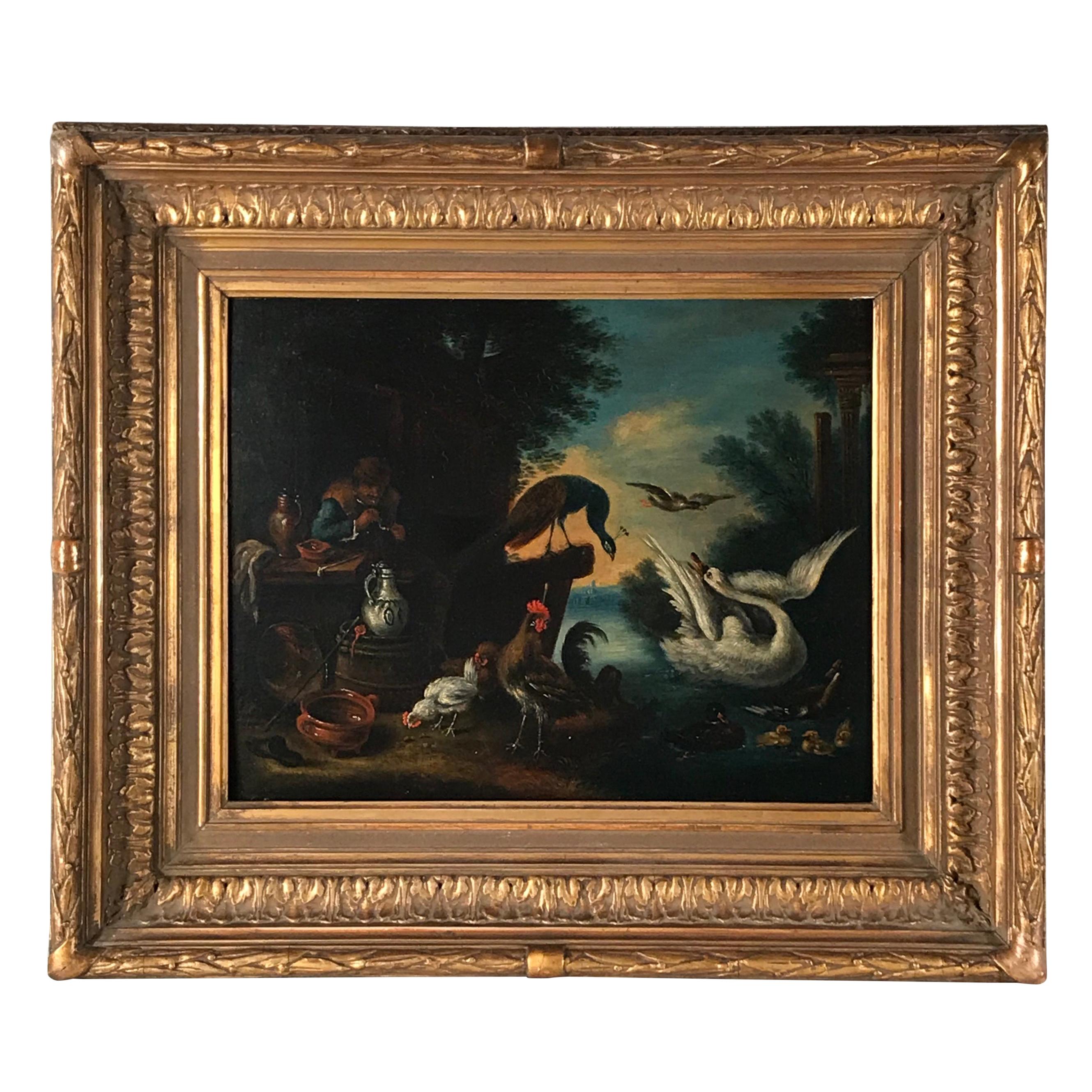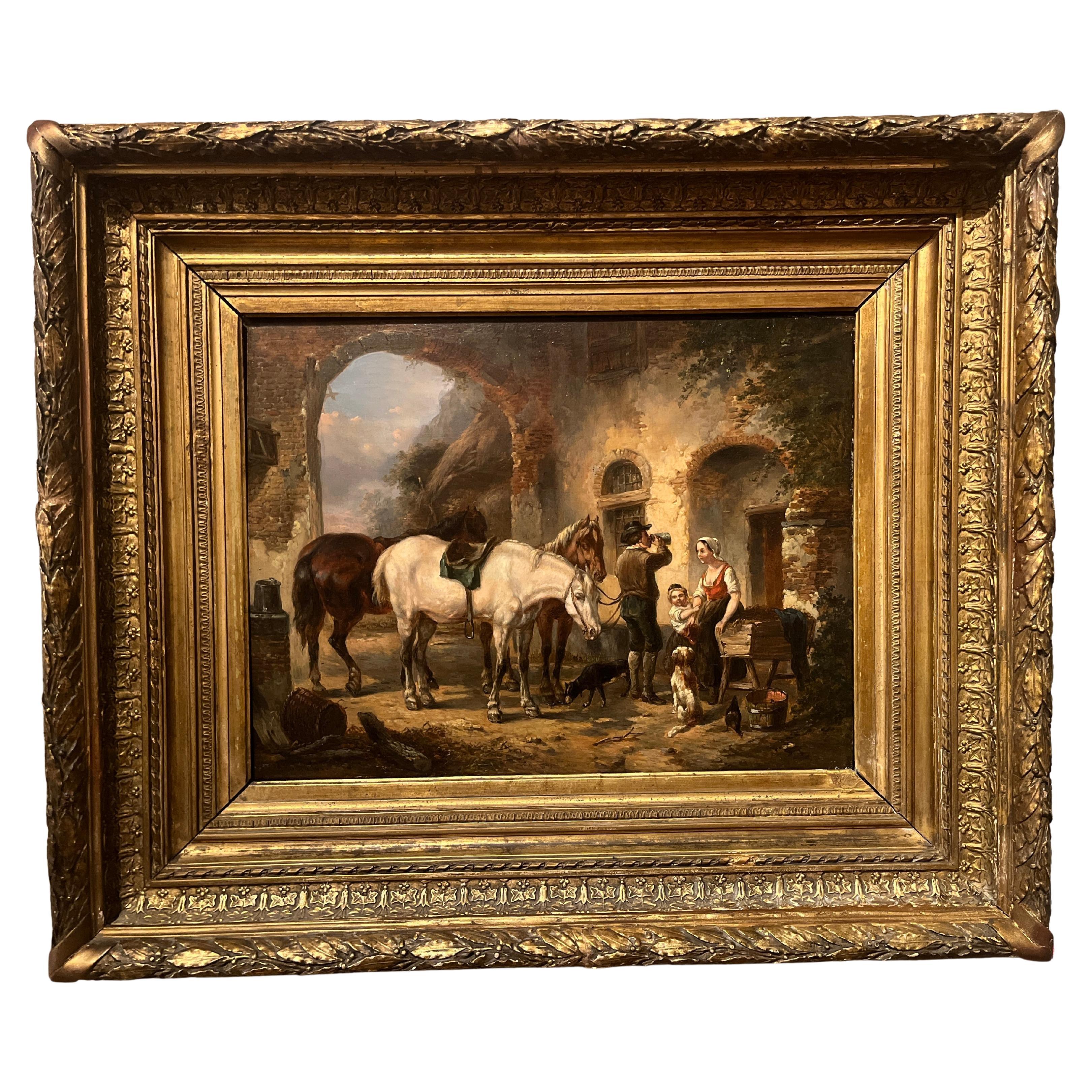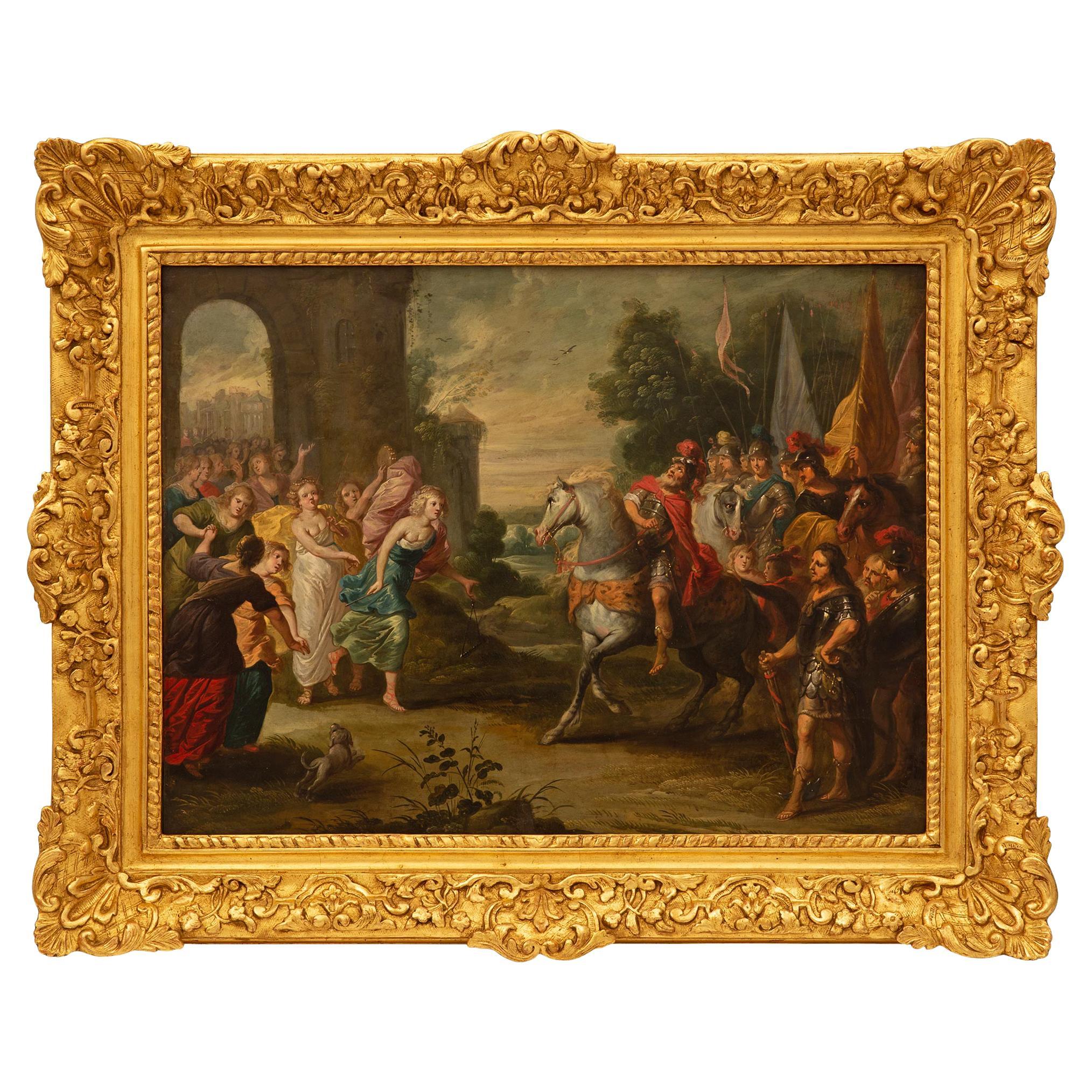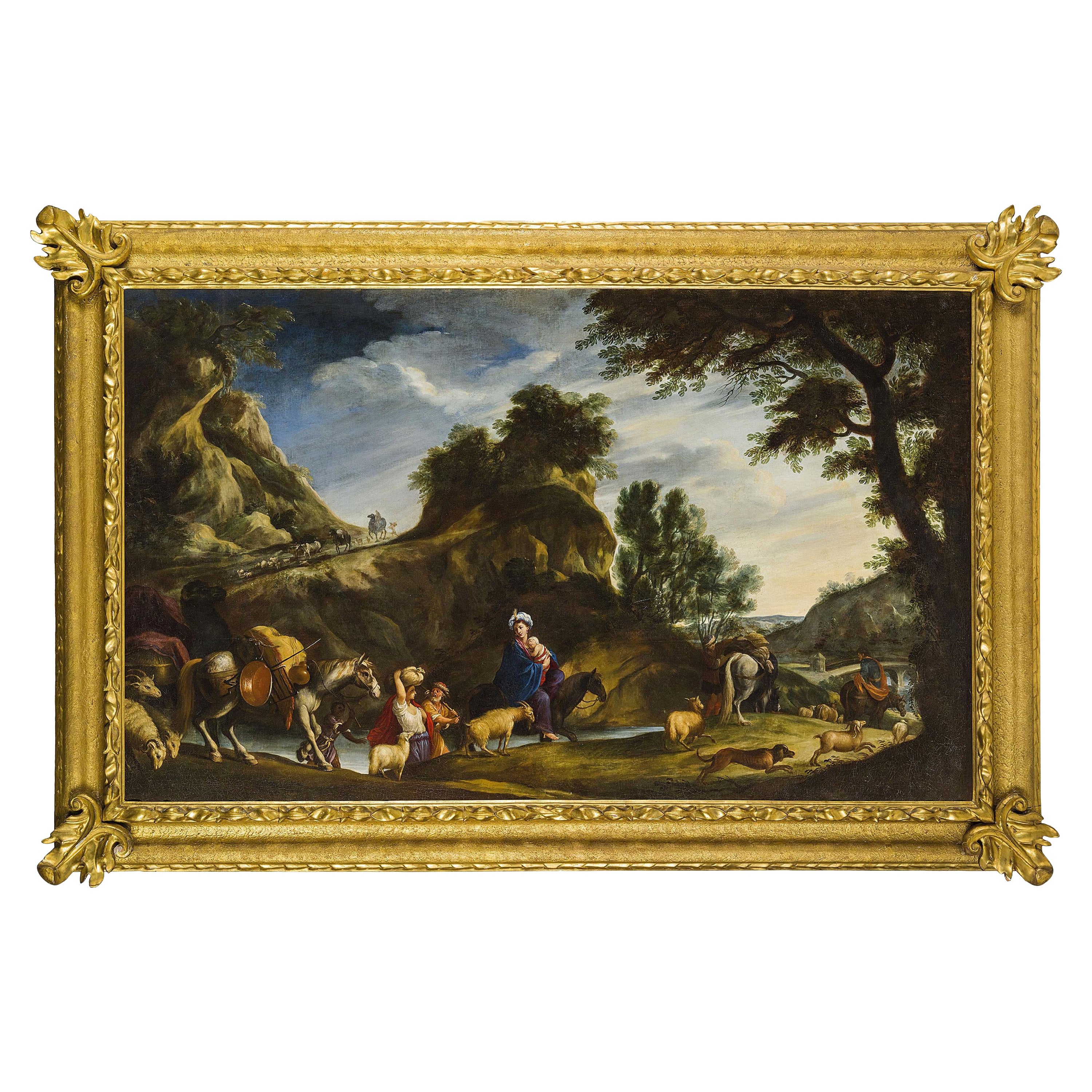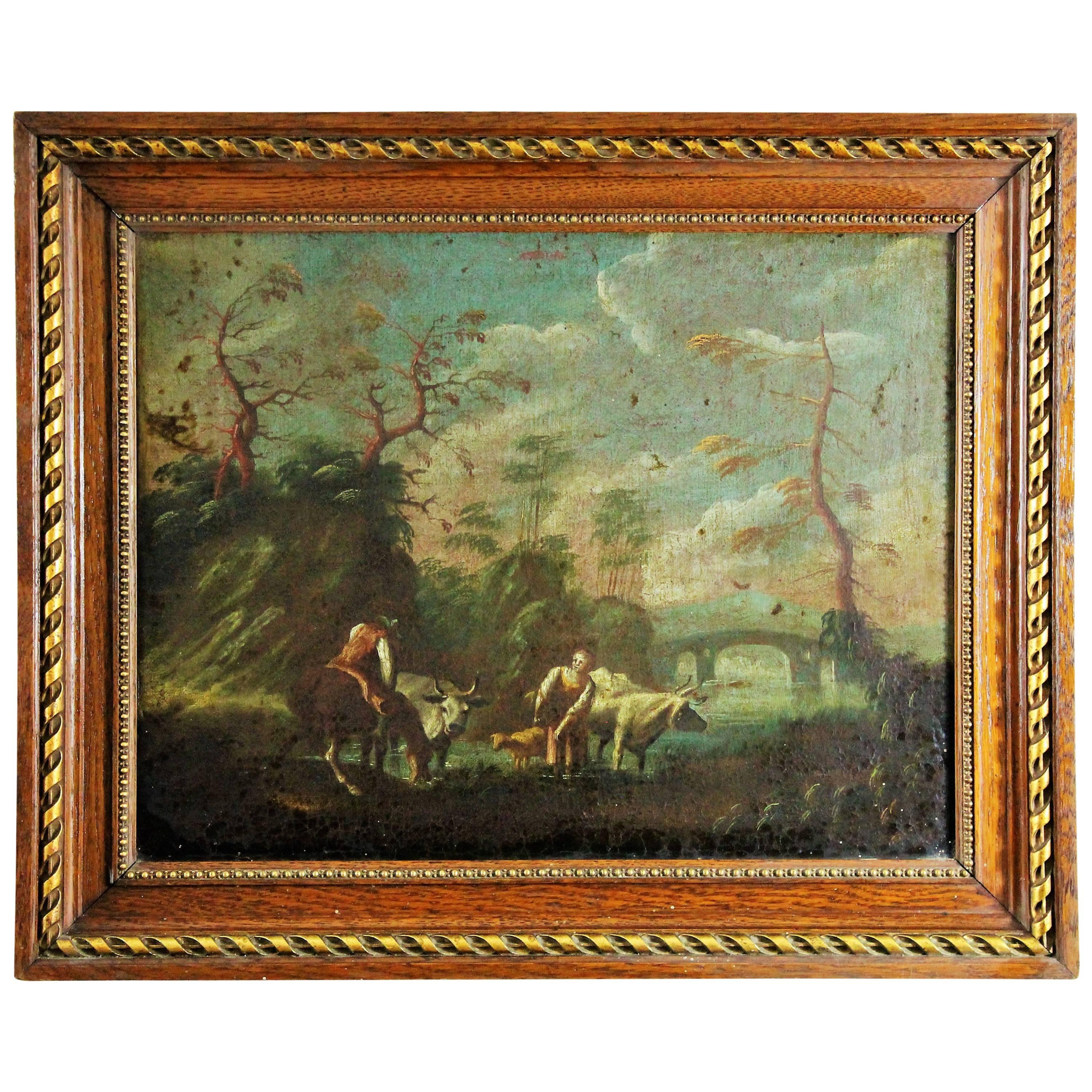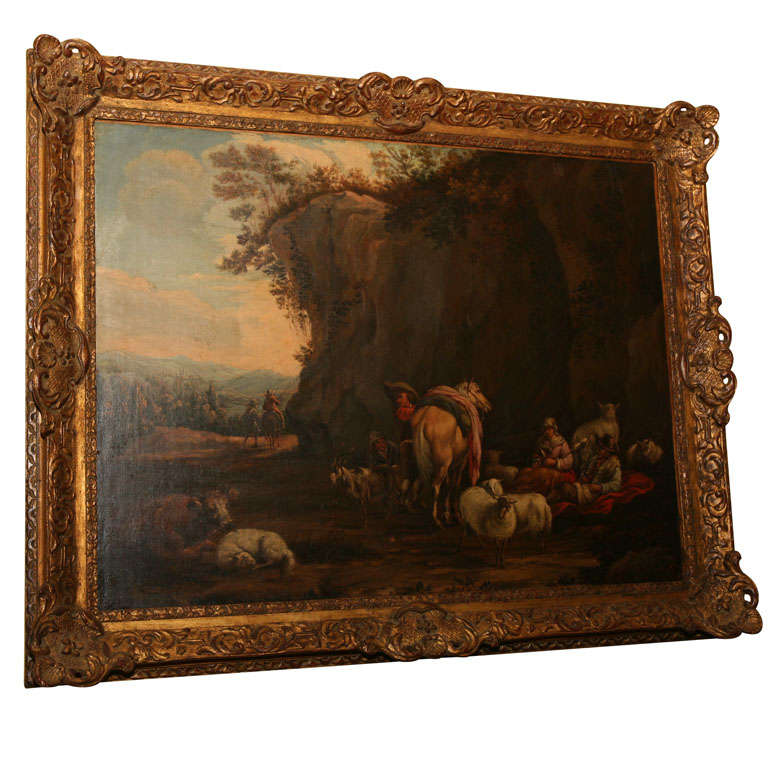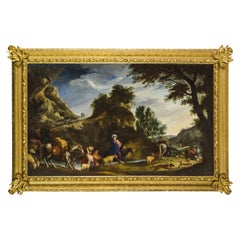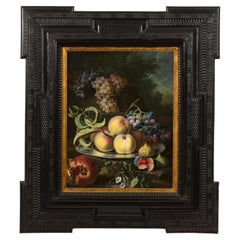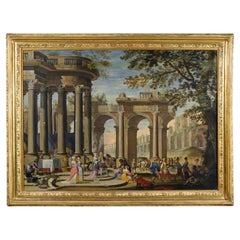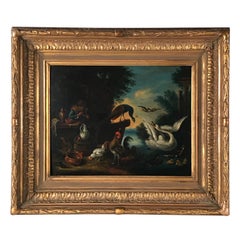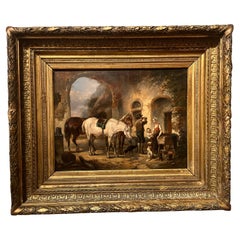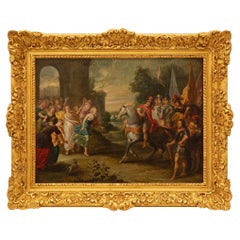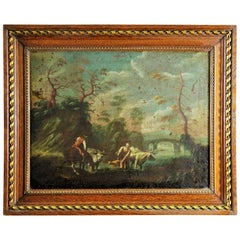Items Similar to 18th Century, Baroque Austran Painting by August Querfurt
Want more images or videos?
Request additional images or videos from the seller
1 of 15
18th Century, Baroque Austran Painting by August Querfurt
$14,857.84
£11,064.45
€12,500
CA$20,513.25
A$22,741.97
CHF 11,951.79
MX$278,324.41
NOK 149,265.74
SEK 140,100.83
DKK 95,170.83
About the Item
August Querfurt (1696, Wolfenbüttel - 1761, Vienna)
Farmers and villagers at the entrance of a village
Oil on panel , cm 38,5 x 51. frame 66 x 53,5 x 4,5 cm
The valuable painting, with a great chromatic impact thanks to the technique of oil on board, depicts a lively scene of daily life in the countryside, set near the entrance door of a village. The episode of rural life, depicted with great vitality, through the use of quick touches of color and material, illustrates right, at the gates of the village, a cart loaded with hay and two farmers at work. Next to them sit some figures who stand beside their horses. A woman on her horse reaches a passer-by while behind a shepherd walks with his dog next to him. On the left, a child sits on his back while playing with dogs next to a horse, who is resting while sitting. The entrance to the village is characterized by an arched passage between ancient walls, described with poetic rovinism, as well as some houses. The clear sky is marked by some grey white clouds.
The work is signed with the letters A.Q. at the bottom right, recognizable in the monogram that Georg Kaspar Nagler indicates in his famous volume as belonging to the painter August Querfurt. His description informs us that the "Painter of battles of Wolfenbuttel (Germany), pupil of his father Tobias, painted in the style of Burgundy. In some of his works, which also depict hunting, are the initials of the name. He was stabbed at the hands of J. Burdé and A. Balzer. This master died in Vienna in 1761".
The stylistic comparison with the works signed and traced back by critics to Querfurt’s hand show similarities both in the artist’s characteristic technique, in the colour used and in the choice of subjects.
You can recognize some typical characters of the bambocciate of the master such as the drafting of color, with easy and fast brushstrokes proving to be skilled, through the highlights, in the yield of volumes and depths. The painter carefully describes the different protagonists, their gestures and clothing; attention that indicates a study from the truth of everyday life, read and interpreted with naturalism.
August Querfurt was born in Wolfenbuttel, Vienna in 1696 and is best known for his subjects depicting soldiers and battle scenes, certainly influenced by Philips Wouwerman’s painting.
Educated by his father, Tobias Querfurt, painter of landscapes and animals at the court of Brunswick, he later studied with Georg Philipp Rugendas (Augsburg 1666-1742) in Augsburg.
In 1752, Querfurt became a member of the Academy of Vienna. He had important commissions, as evidenced, among others, the twelve canvases, some large, made for Duke Charles Alexander of Württemberg and the eight paintings commissioned by Empress Maria Theresa depicting war events related to the War of the Austrian Succession (1740-1748). The works for the Empress are now housed in the Museum of Military History located in Vienna. Querfurt lived in a very turbulent period: the Holy Roman Empire, the Ottoman Empire, the Habsburgs, Great Britain and a number of other forces fought several battles near Vienna where Querfurt lived.
In the Austrian capital he died in 1761.
Some of his works are now exhibited at the Belvedere Palace in Vienna, at the National Gallery of Augsburg, others are in Berlin, Dresden, Stuttgart and Bratislava.
[… ]
In conclusion, the discovery of this work together with the recognition of the monogram, allows to add to the corpus of works of August Querturt a valuable testimony of his technical abilities and the confirmation that he was a talented painter of subjects different to the genre of battles to which in the past was exclusively traced.
We apologize for any translation errors. Please contact to have the expertise in Italian.
outlining more clearly the figure of the author.
- Dimensions:Height: 21.26 in (54 cm)Width: 25.99 in (66 cm)Depth: 1.97 in (5 cm)
- Style:Baroque (Of the Period)
- Materials and Techniques:
- Place of Origin:
- Period:
- Date of Manufacture:18th Century
- Condition:
- Seller Location:IT
- Reference Number:1stDibs: LU4405217793742
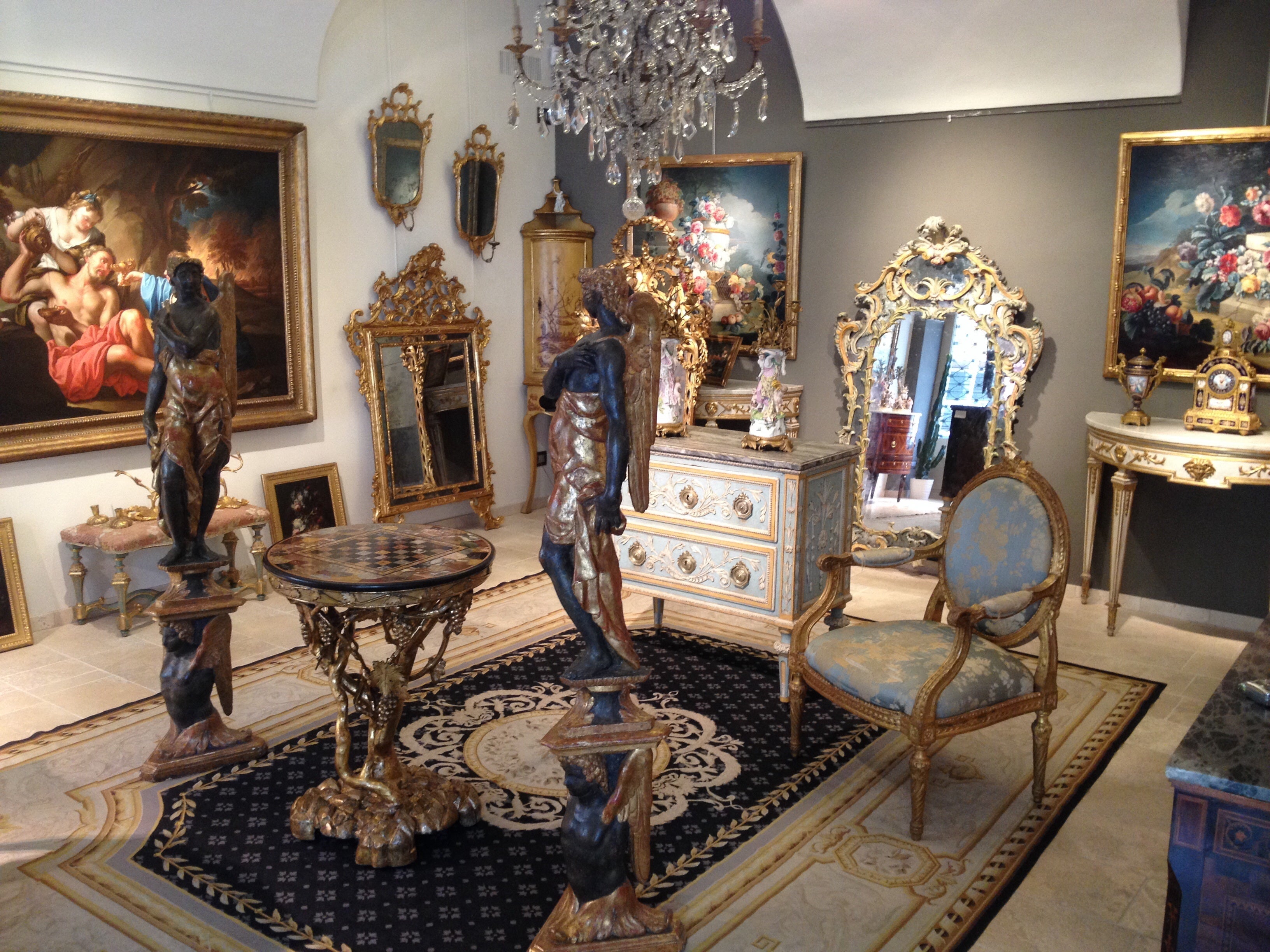
About the Seller
5.0
Platinum Seller
Premium sellers with a 4.7+ rating and 24-hour response times
Established in 1980
1stDibs seller since 2019
56 sales on 1stDibs
Typical response time: <1 hour
- ShippingRetrieving quote...Shipping from: Italy
- Return Policy
Authenticity Guarantee
In the unlikely event there’s an issue with an item’s authenticity, contact us within 1 year for a full refund. DetailsMoney-Back Guarantee
If your item is not as described, is damaged in transit, or does not arrive, contact us within 7 days for a full refund. Details24-Hour Cancellation
You have a 24-hour grace period in which to reconsider your purchase, with no questions asked.Vetted Professional Sellers
Our world-class sellers must adhere to strict standards for service and quality, maintaining the integrity of our listings.Price-Match Guarantee
If you find that a seller listed the same item for a lower price elsewhere, we’ll match it.Trusted Global Delivery
Our best-in-class carrier network provides specialized shipping options worldwide, including custom delivery.More From This Seller
View All17th Century, Italian Painting by Pier Francesco Cittadini, Jacob and his Family
Located in IT
Pier Francesco Cittadini (Milan, 1616-Bologna, 1681)
"Jacob and his family go to Egypt"
Oil on canvas, cm 109 x 190 (canvas only)
The valuable painting, made in oil on canvas, depicts Jacob and his family go to Egypt and we believe it can be, given the high quality painting, autograph work of Italian Pier Francesco Cittadini (Italy Milan, 1616 - Bologna, 1681) made after 1647. The work, in excellent condition is accompanied by a coeval frame in wood finely carved and golden.
The scene depicted, which was confused with the Flight to Egypt in the past years, is instead identified with the biblical episode of Jacob’s journey. In the foreground, reading the painting from left to right, we see a caravan composed of animals, including donkeys, dromedaries, goats, dogs and horses and people, women, men and slaves, who carry on their journey along the banks of a river, following a path that to the right, would seem to lead to the through of a bridge. In addition to the watercourse is described an environment characterized by large rocks and impervious come far to cover the entire verticality of the canvas. On the left, in the distance, we see the tail of the caravan that runs along the steep path. Large trees enliven and harmonize the environment, as well as white and grey clouds characterize the predominantly clear sky and illuminated on the right by sunlight.
The story is told in the Bible, Book of Genesis, 30, 25, passage in which is described the flight of Jacob from Haran after the contrasts with Laban, father of his wife Rachel. Jacob is the third great patriarch of the Bible. From his descendants originate the twelve generations of the people of Israel. He is the son of Isaac and Rebekah, who led him to flee from the wrath of Esau to Haran to seek refuge from his brother, Laban. At his uncle’s house Jacob met his daughter Rachel. As soon as he saw his cousin, Jacob was taken. Jacob will stay seven years in the service of Laban to marry his beloved Rachel. But Laban, with a deception, will give him in marriage first Lia, the least beautiful eldest daughter, and only after another seven years the splendid Rachel. From his first wife he will have several children, while Rachel will give birth to the beloved son, Joseph, who will become viceroy of Egypt.
After years of service, Jacob asked to be paid with every dark-coloured garment among the sheep and every spotted and dotted garment among the goats. Laban accepted and sent away from his sons all the leaders of that kind. So Jacob took fresh branches of poplar, almond and plane tree, and flayed them, and put them in the troughs. The optical suggestion induced the goats and the sheep to conceive and give birth to dark, striped and dotted garments. He also ensured that all the strongest and healthiest leaders of the flock of Laban would drink near the barked branches, thus assuring a genetic superiority to his part of the flock. His flocks grew numerous and strong and he became richer than his relative, arousing envy. It was clear that Laban would not respect him much longer. At the suggestion of the Lord, Jacob decided to return to Canaan. Trying to avoid any possible dispute, he left with his family while Laban was absent for shearing sheep. But when, three days later, his uncle returned home, he became angry, feeling offended because Jacob had gone secretly and had not allowed him to greet his daughters and grandchildren. In addition, his teraphim, statuettes, or idols, which depicted the family deities, had disappeared. After 7 days of pursuit, Laban and his men reached Jacob’s group on Mount Gilead, in the mountainous region west of the Euphrates River, where his uncle and grandson had a stormy conversation. The younger man was outraged at being accused of stealing idols and told Labano to rummage through his family’s tents at will. Neither of them could know or even imagine that it was Rachel who took the idols and hid them in the saddle of the camel. During the search, she sat down firmly on the saddle, apologizing for not being able to get up, «because I usually have what happens to women» (Gen 31:35). So the loot wasn’t discovered.
The author of this work was inspired by the composition of an engraving by Stefano Della Bella (1610-1664) of circa 1647. The engraving by Stefano della Bella bears the title "Iacob sur ses vieux jours quitte sans fascherie pour voir son filz Ioseph, sa terre et sa patrie" and is signed on the bottom left "Stef. of the Beautiful In. et fe." while on the right it is declared "Cum privil. Regis", that is with license of the king.
Stefano Della Bella (Italy - Florence, May 18, 1610-Florence, July 12, 1664) was born in a family of painters, sculptors and goldsmiths and was left early orphan of his father sculptor, he dedicated himself first to the art of goldsmith at the school of Giovanni Benedetto Castiglione and Gasparo Mola, then turning his attention to drawing and engraving. He soon began drawing figures and copying the etchings of Jacques Callot, which inspired his early works. Under the protection of the Medici, in particular of Don Lorenzo, cadet son of Grand Duke Ferdinand I, Della Bella has the opportunity to make study trips to Rome, where he stayed from 1633-1636; In Rome he met French engravers and publishers of prints such as Israël Henriet and François Langlois, who influenced his decision to move to Paris in 1639, four years after the death of Callot. In Paris he soon reached, thanks to the engravings commissioned by Cardinal Richelieu, the success also worldly; he frequented courtiers, theatre artists and writers, while refusing too oppressive honors. In 1646-1647 he continued his travels in the Netherlands to Amsterdam, Antwerp and Dordrecht. He returned to Florence in 1650 and resumed working under the protection of the Medici court, working for his patrons. In 1656 he became a member of the Academy of Apatists.
The painting object of this study is reasonably attributable to Pier Francesco Cittadini, or Pierfrancesco Cittadini, called the Milanese or the Franceschino (Italy - Milan, 1616-Bologna, 1681) as some exemplary stylistic comparisons proposed to follow can prove.
Pier Francesco Cittadini was an Italian baroque painter, mainly active in Bologna.
His artistic training first took place with the painter Daniele Crespi...
Category
Antique Mid-17th Century European Baroque Paintings
Materials
Canvas, Giltwood
18th Century, Painting with Still Life by Maximilian Pfeiler
Located in IT
Maximilian Pfeiler (active Rome, circa 1694-circa 1721 Budapest)
Still life with peaches, grapes, figs and pomegranate
Oil on canvas, Measures: cm H 63,5 x W 47. With frame cm ...
Category
Antique Early 18th Century Italian Baroque Paintings
Materials
Canvas, Wood
18th Century, Painting Architectural Capriccio, att. to Isaac De Moucheron
Located in IT
18th Century, Painting with Architectural Capriccio with figures, attributed to Isaac De Moucheron
Measures: canvas cm H 108 x L 152; with frame cm H 132 x L 176 x 8
The painting i...
Category
Antique 18th Century Dutch Baroque Paintings
Materials
Canvas
18th Century, Italian Painting Depicting Landscape with Watermill and Characters
Located in IT
18th century, Italian painting depicting landscape with watermill and characters
Oil on canvas; Measurements: frame cm L 103.5 x H 127 x P 5; painting L 93 x H 117.5
The painting...
Category
Antique Mid-18th Century Italian Rococo Paintings
Materials
Canvas
18th Century, Italian Still Life Painting Attributed to Francesco Lavagna
By Francesco Lavagna
Located in IT
Francesco Lavagna (Italy -Naples 1684-1724)
"Still life with flowers and watermelon and hermas with garden in the background"
The painting, beautifully made and in good condition, d...
Category
Antique Early 18th Century Italian Baroque Paintings
Materials
Canvas
18th Century, Italian painting Depicts Bambocciata by Giovanni Michele Graneri
Located in IT
Giovanni Michele Graneri (Italy, Turin 1708-1762)
Bambocciata (Farmers dancing in front of the inn)
The painting, made in oil on canvas, depicts a moment of celebration where some p...
Category
Antique Mid-18th Century Italian Baroque Paintings
Materials
Canvas
You May Also Like
Unknown Flemish Artist, 18th Century
Located in Belmont, MA
Unknown Flemish Artist, Belgium 18th century, in the right part of the painting the artist represented a man sitting in front of a tavern. He is surrounded by Delft baroque earthenware pitchers and plates. The right side of the painting shows different types of birds, among them chicken, a swan, ducks and a peacock. The painter was here definitely inspired by the 17th century painter Melchior de...
Category
Antique 1770s Belgian Baroque Paintings
Materials
Hardwood
19th Century Wouter Verschuur original oil painting
By Wouterur Verschuur
Located in Scottsdale, AZ
17th Century Wouterur Verschuur original oil painting of 2 horses and man greeting woman and child. Signed lower left. Oil on board in what appears to be the original frame. Procur...
Category
Antique Early 19th Century Danish Baroque Revival Paintings
Materials
Paint
Flemish Late 17th Century/Early 18th Century Oil on Canvas Painting
Located in West Palm Beach, FL
A stunning and most impressive Flemish late 17th century/early 18th century oil on canvas painting possibly by Frans Francken III. The beautiful and...
Category
Antique 17th Century Dutch Paintings
Materials
Canvas, Giltwood
Oil on Canvas Paint Flemish School, 17th Century Belgium
Located in Beuzevillette, FR
Oil on canvas depicting a country scene: a man watering his horse near a river where two cows and a sheep wade accompanied by a farmer.
Work of northern France or Belgium of the 17t...
Category
Antique 17th Century Belgian Paintings
Materials
Canvas
A late 18th Century Italian Painting
Located in Hudson, NY
This lovely and decorative painting of peasants in a bucolic setting with numerous farm animals is typical of the period and is designed to illustrate happier moments and a getting b...
Category
Antique Late 18th Century Italian Paintings
Materials
Canvas, Wood
Late 18th-Early 19th Century Continental Landscape Painting
Located in Chapel Hill, NC
Late 18th-early 19th century capriccio (imaginary) landscape, Continental. A shepherd & animals at hillside "barns" below Italianate church & fortress. Acquired in the late 1940s by ...
Category
Antique Early 19th Century European Romantic Paintings
Materials
Canvas
More Ways To Browse
Antique Furniture Brunswick
Roman Dog
Antique Drafting Sets
Dresden Dog
Maria Theresa Painting
King Ludwig Ii
Scott Kerr
Used Furniture Croydon
Used Furniture Reading Pa
Verre Eglomise Painting
Wagner Plaque
Women Naked Painting
After Murillo
American Federal Portrait
Antique Furniture Islington
Boy Hoop
Gordon Roberts
Highland House Furniture
